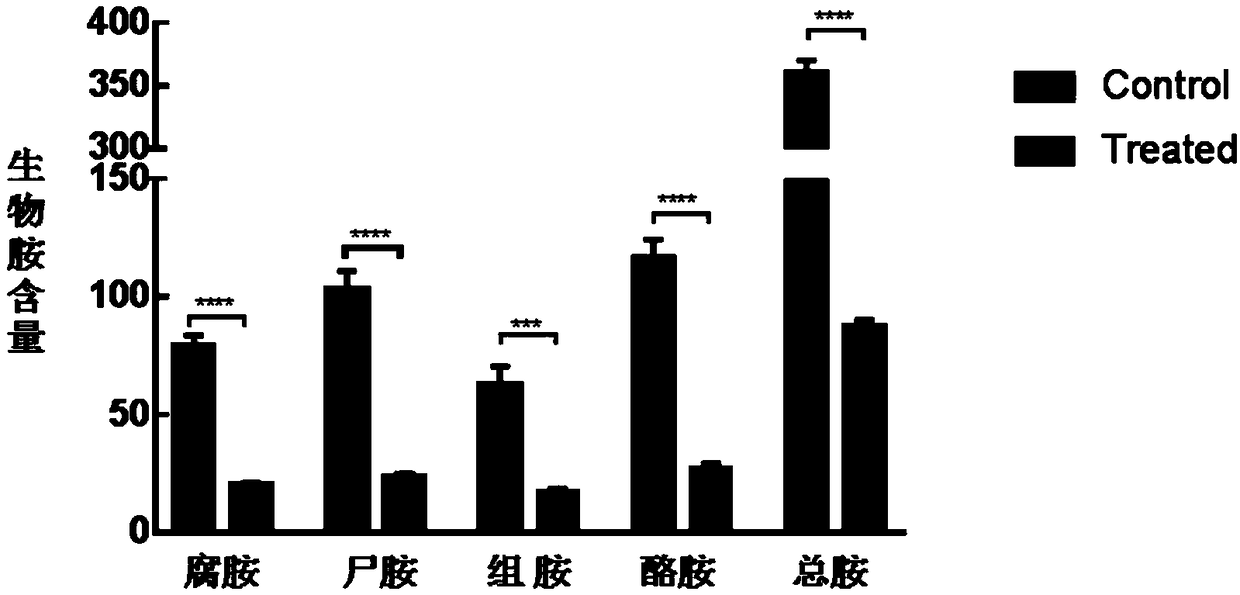Method capable of reducing biogenic amine in fermented sausage and application thereof
A fermented sausage and biogenic amine technology, which is applied in food science, DNA/RNA fragments, recombinant DNA technology, etc., can solve the problem of reducing biogenic amine, and achieve the effects of strong targeting, high efficiency and wide application prospects
- Summary
- Abstract
- Description
- Claims
- Application Information
AI Technical Summary
Problems solved by technology
Method used
Image
Examples
Embodiment 1
[0043] The role of L-E-siRNA complex in naturally fermented sausage
[0044] The production process of naturally fermented sausage is: raw meat → pretreatment → mincing → adding ingredients to marinate → enema → fermentation → ripening → product. →
[0045] The contents of biogenic amines in naturally fermented sausages are shown in Table 1.
[0046] Table 1 Contents of biogenic amines in naturally fermented sausages (mg / kg)
[0047]
[0048] In this example, the L-E-siRNA complex was not used.
[0049] (1) Design the E-siRNA sequence.
[0050] (2) Preparation of E-siRNA.
[0051] (3) Weigh 4 mg of soybean lecithin, 4 mg of DOTAP, 2 mg of cholesterol, and 2 mg of DSPE-PEG2000 to prepare cationic liposomes.
[0052] (4) Construction of L-E-siRNA: The positive and negative charge ratio of siRNA mixture and liposome mixture is about 2:1, vortex for 5 minutes, and incubate at room temperature for 15 minutes to form siRNA-liposome complexes. The particle diameters of Enter...
Embodiment 2
[0060] Example 2: Effect of L-E-siRNA complex in Western-style fermented sausage
[0061] The production process of Western-style fermented sausage is: raw meat → pretreatment → mincing → adding ingredients, marinating → enema → fermentation → ripening → product. →
[0062] Table 3 Content of biogenic amines in Western-style fermented sausage (mg / kg)
[0063]
[0064] In this embodiment, the L-E-siRNA complex is also applied:
[0065] (1) Design the E-siRNA sequence.
[0066] (2) Preparation of E-siRNA.
[0067] (3) Weigh 3 mg of soybean lecithin, 3 mg of DOTAP, 1.5 mg of cholesterol and 1.5 mg of DSPE-PEG2000 to prepare cationic liposomes.
[0068] (4) Construction of L-E-siRNA: The positive and negative charge ratio of siRNA mixture and liposome mixture is about 1:1, vortex for 5 minutes, and incubate at room temperature for 20 minutes to form siRNA-liposome complexes. The particle sizes of Enterobacter aerogenes and Enterobacter cloacae siRNA-liposome complexes were...
PUM
 Login to View More
Login to View More Abstract
Description
Claims
Application Information
 Login to View More
Login to View More - R&D Engineer
- R&D Manager
- IP Professional
- Industry Leading Data Capabilities
- Powerful AI technology
- Patent DNA Extraction
Browse by: Latest US Patents, China's latest patents, Technical Efficacy Thesaurus, Application Domain, Technology Topic, Popular Technical Reports.
© 2024 PatSnap. All rights reserved.Legal|Privacy policy|Modern Slavery Act Transparency Statement|Sitemap|About US| Contact US: help@patsnap.com










